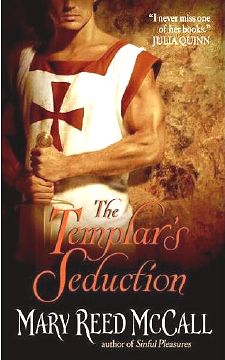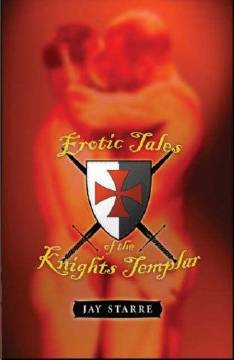I continue to be boggled by the amount of bizarrerie that gets published/filmed (some of it purportedly 'non-fiction') about the Knights Templar. They were not exotic, they were not mysterious. They were just the armed franchise of the Cistercians, who were suppressed and persecuted by Philip IV and Clement V in the early 14C on trumped-up heresy charges.
One of the things that both amuses and angers me greatly is the determination of so many popular writers to cling to the "no smoke without fire" argument. However, less likely guardians of arcane and elevated knowledge – Gnostic or Essene scriptures, Sufism, the Holy Grail, secret divine bloodlines, & c. – would be hard to find: the Templars were notoriously the least educated of all the monastic orders. Most of them had trouble with standard Church Latin (this is what it means to be "illiterate" in mediæval terms), let alone anything more exotic. They were even hazy about ecclesiastical terminology, which got them into trouble: "venerating" relics was OK, "worshipping" them could be made to sound dubious; and some were muddled about lay absolution. Their naïvety and lack of scholarship made them easy prey for the lawyers of the Inquisition and of the King of France.
They were only linked with Freemasonry in the 18C, by German and French occultists. The 18C Jacobite Masonic writer, Andrew Ramsay, had previously tried to link the Craft with the Hospitallers (hence so many St John's Lodges), but a) they were still in existence as an order; b) did not have the symbolic resonance of the connection to Solomon's Temple; and c) were not mysterious and exotic enough. 19-20C occultists, conspiracy theorists and flakes of one sort or another have elaborated on these foundations, linking them with devil-worship, pagan gay sex-cults, Bannockburn, Rosslyn Chapel (which is 15C, well post-Templar), the Ark of the Covenant, the Grail and/or descendants of Jesus and Mary Magdalene, being closet Muslims, the Illuminati, and even 'discovering' North America (what would they do that for?!). A classic way of avoiding having to provide actual documentary evidence is to claim that 'the world is not yet ready for it', as per Archie McKerracher in "Bruce's Secret Weapon", The Scots Magazine, June 1991, claiming that "The Scottish Knights Templar possess a secret and different version of Scotland's history which is contained in their Stella Templum, of which the above article forms part. The rest is considered too controversial for release at present".
It all makes for a fascinating study of mythmaking and human psychology, not to mention a great deal of unintended hilarity, but has very little to do with the pious military brethren of the Middle Ages.
I recommend as sensible reading-matter:
- Malcolm Barber, The New Knighthood: A History of the Order of the Temple
- Malcolm Barber, The Trial of the Templars (2nd ed.) (I admit that this book made me weep as a student.)
- Alain Demurger, The Last Templar: The Tragedy of Jacques de Molay
- Anne Gilmour-Bryson, The Trial of the Templars in Cyprus
- Helen Nicholson, The Knights Templar: A New History
- Helen Nicholson, Knight Templar 1120-1312
- Peter Partner, The Knights Templar & their Myth
- Judith Upton-Ward, The Primitive Rule of the Templars
Always read the blurb about the author before buying any book on this subject. If a background in occultism/New Age spirituality/popular journalism/claiming to be a Stuart prince is more prominent than having any qualification in mediæval history… you know what to expect. There is no such thing as "alternative history": it's called "fiction".
Acknowledged fiction also does strange and disturbing things with the order. If a fiction-writer invites me to 'blame the victims' for the sake of a story, I can only say "No". I am not a Christian, I have no personal stake (pun intended) in the military orders or their cause, but still I say "No" because I cannot justify flesh-and-blood people being tortured and killed. "No smoke without fire"? There was fire, all right: one priest had his feet so badly roasted during questioning that some of the bones fell out; the Grand Master, an old man in his 70s, was among those burned alive as a relapsed heretic for retracting confessions made under duress and insisting on his innocence. This, with the sanction of the Church they had served faithfully. It is an early manifestation of the universe of the show trial, in which, in Camus's words:
The accused, who will proclaim himself a contemptible traitor, will enter into the Pantheon of mankind; those who maintain their innocence will be condemned to the hell of history.
(The Rebel, "State Terrorism and Rational Terror", p. 208)
In Ivanhoe (1819) and The Talisman (1825), Walter Scott used the Templars as substitutes for the Jesuits and other scheming, sinister monks then popular in Gothic fiction. The pioneering Crusades historian Charles Mills noted this even at the time. However, much can be forgiven re: Ivanhoe, because Brian and Rebecca are by far the most interesting characters, and in screen adaptations are invariably the sexiest. (The usual Scott problem: the nominal leads – in this case, Wilfred and Rowena – are wet, and the secondary ones/baddies are wonderful, throwing the story completely out of balance.) They have even inspired a bizarre manga-style fantasy comicbook, Ravenskull.
The Gothic influence is very apparent in the 1983 BBC serial, The Dark Side of the Sun, which combines Dracula-esque Gothic Romance plot elements with modern Templar/Masonic conspiracy theories. (This was not long after The Holy Blood & the Holy Grail came out, and one can detect echoes of the 'Priory of Sion' hoax, as well as the Vatican Bank scandal.) The historical back-story seems indebted to the misbehaviour (and deposition) of the Hospitaller Grand Master, Folco or Foulques de Villaret. The 'demonic heads' motif from the Templar trial allegations surfaces, too. David Rice's site on the author, M J Bird, has an excellent section on it: Dark Side of the Sun (thanks to him for the picture). However, Bird also has the Scott problem with drippy nominal leads. Many of us were positively rooting for the astoundingly thick young historian, David, to be killed: he has "Darwin Award" written all over him. And I know I wasn't the only viewer whose idea of a happy ending would have been for the elegant and charming (if occasionally murderous) Raoul to go off with the equally elegant and charming (and knife-wielding) clairvoyant psychiatrist, Ismini… And frankly, I'd love to let him exercise his psychic warfare skills on some of the self-styled 'non-fiction' writers on the order, and the 'historical romance' novelists (no doubt having seduced them utterly first!)! (See also my IMDb review and longer article on the serial.)
Naughty Knights we love… |
||
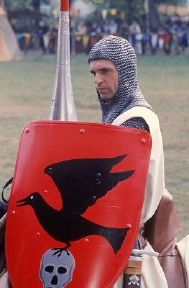 |
 |
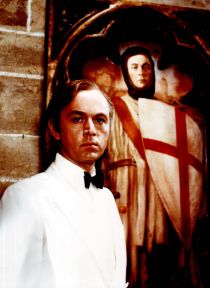 |
| Brian de Bois-Guilbert in Ivanhoe (played by Sam Neill (non-reg shield) & Ciaran Hinds (properly bearded!)) |
Raoul Lavallière in Dark Side (played by Peter Egan) |
|
Some New Age-y writers also depict the Templars as 'guardians of secret knowledge' of one sort or another, but make them heroes rather than villains. There are some decidedly odd novels by Katherine Kurtz and Deborah Turner Harris that try to link them to the Holy Grail, William Wallace and Robert I (de Bruce) in a pseudo-historical fantasy Scotland. The fact that the blurb on The Temple & the Stone refers to William Wallace as "the Highlander" (a knight of Shropshire/Welsh descent, from Ayrshire or Renfrewshire?!) known as "Braveheart" (invented for the film!) makes it immediately off-putting. The authors appear to be unaware that there were hardly any Templars in Scotland (the military orders did not have much of a presence here at all in erms of personnel), and that they were under the jurisdiction of London HQ: the Preceptor of England was killed in battle at Falkirk fighting against Wallace. The fantasy that fugitive Templars found refuge in Scotland when Robert was excommunicated is simply that: there is no evidence for it. (And I really, really wish US fantasy/romance writers would stop using my country as some sort of theme-park for far-fetched romantic ramblings!) With Scott MacMillan, Kurtz also writes novels in which Templar vampires battle Nazi vampires… Stephen Lawhead has also written a series called The Celtic Crusades, which combines pseudo-Celtic and 'Templar' mysticism. At least overt fantasy elements should prevent readers from taking the contents seriously… but one can never be too sure.
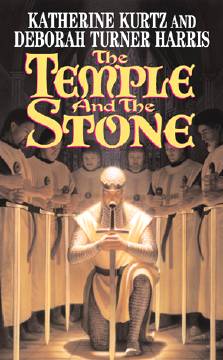 |
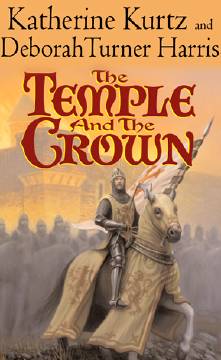 |
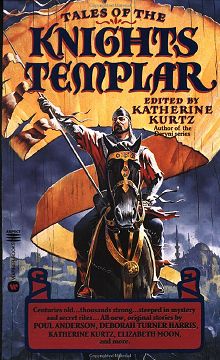 |
Another weird recent trend, post-Da Vinci Code, is for Templars (or ex-Templars) to be romantic/erotic heroes in 'historical romances' (aka 'bodice-rippers', or this case, 'habit-rippers'), straight and gay. I'm not sure where all these clean-shaven hunks come from. Despite their graceful habits, Templars were a mediæval fashion-disaster with their short-ish hair and long beards. They slept in their clothes, and were not allowed to laugh or make idle chatter. Even if they went secular post-suppression (most just transferred to other monasteries or the Hospitallers: they were not supposed to break their vows), they would have been institutionalised and rusty about matters amorous – unless the sodomy allegations were true (in which case, there may be more plausibility in gay steamy romance/erotic fiction such as the middle example below!).


